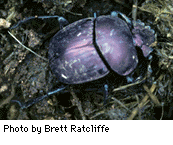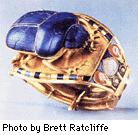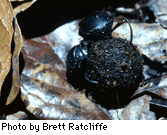
If it were not for dung beetles, members of the scarab family, every terrestrial organism would be up to its eyeballs in you know what
 "Before the sun becomes too hot, they are there
in their hundreds, large and small, of every sort, shape and size, hastening to carve
themselves a slice of the common cake," is how the 19th-century French entomologist
and writer J. Henri Fabre described the feeding frenzy of dung beetles. These industrious
insects, reports first-time Smithsonian writer David C. Holzman, bury nearly half a ton of
dung per acre per year as food for themselves and their offspring.
"Before the sun becomes too hot, they are there
in their hundreds, large and small, of every sort, shape and size, hastening to carve
themselves a slice of the common cake," is how the 19th-century French entomologist
and writer J. Henri Fabre described the feeding frenzy of dung beetles. These industrious
insects, reports first-time Smithsonian writer David C. Holzman, bury nearly half a ton of
dung per acre per year as food for themselves and their offspring.
 They
belong to a family with a better-known and far less repulsive name: scarabs, some 7,000
species of which are dung beetles. Dung beetles are naturally present on every continent
except Antarctica. "There are beetles that tunnel directly under the pad, dragging
dung down with them. These beetles are veritable earthmoving machines," writes
Holzman. "Others fashion balls and roll them away from the crowd. Still others simply
jump into the dung and chow down."
They
belong to a family with a better-known and far less repulsive name: scarabs, some 7,000
species of which are dung beetles. Dung beetles are naturally present on every continent
except Antarctica. "There are beetles that tunnel directly under the pad, dragging
dung down with them. These beetles are veritable earthmoving machines," writes
Holzman. "Others fashion balls and roll them away from the crowd. Still others simply
jump into the dung and chow down."
 Dung
beetles have evolved to fill all sorts of ecological niches. There are those that roll
balls of howler monkey dung off leaves high in the treetops. There are those that
specialize in the ordure of sloths, animals that bury their dung. The beetles wait until
just the right moment before jumping into the sloth's hole.
Dung
beetles have evolved to fill all sorts of ecological niches. There are those that roll
balls of howler monkey dung off leaves high in the treetops. There are those that
specialize in the ordure of sloths, animals that bury their dung. The beetles wait until
just the right moment before jumping into the sloth's hole.
Besides clearing the ground, the beetles' activity fertilizes the soil. Using dung beetles more efficiently in agriculture, according to one USDA scientist, could save U.S. farmers up to $2 billion a year by restoring grazing land, recycling the nitrogen that normally is lost to the atmosphere and reducing the populations of bloodsucking flies that stunt the growth of livestock. In Oklahoma, one rancher has counted 11 native species on his land. "Once the cattle have vacated the paddock," he reports, within 48 hours "there is no manure left."
For the ancient Egyptians, the scarab symbolized regeneration and renewal. For modern ranchers, the dung beetle could be just as important.
Abstract of an article by David C. Holzman, originally published in the June 1997 issue of Smithsonian Magazine. All rights reserved.
Copyright 1997 Smithsonian Magazine All rights reserved.
Email: edletters@aol.com
This site produced by Oculus Interactive.
With consulting from Visionary Media.